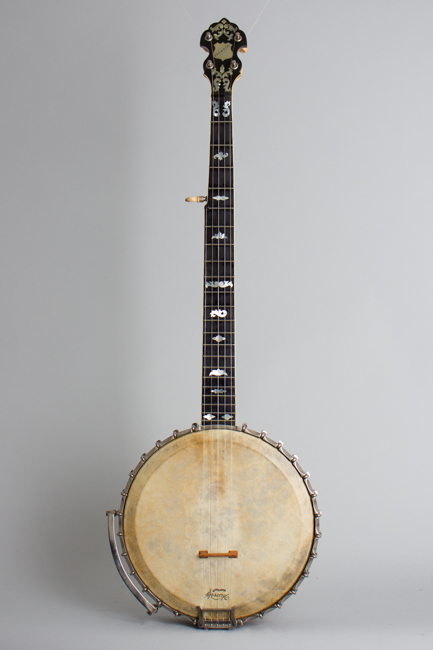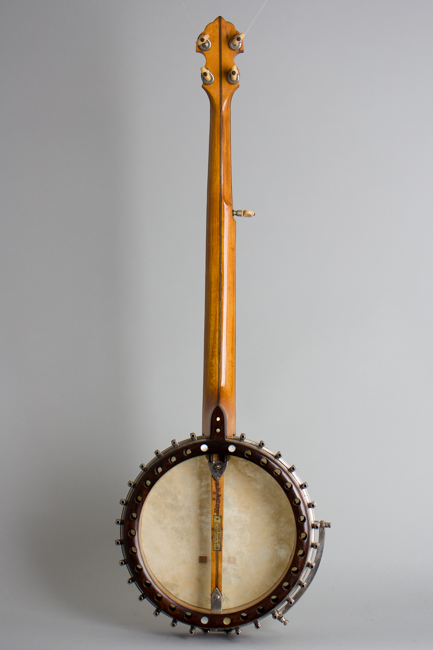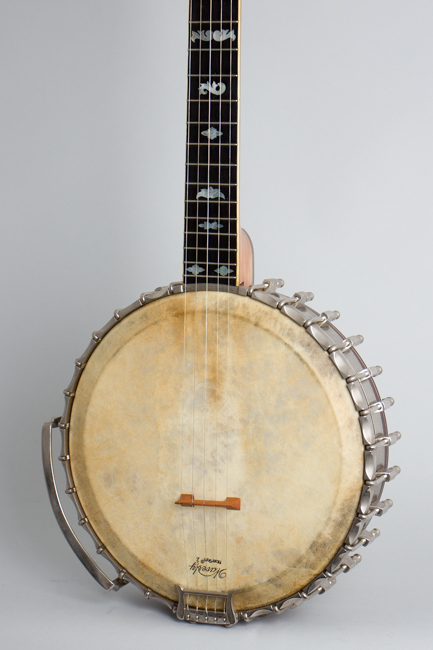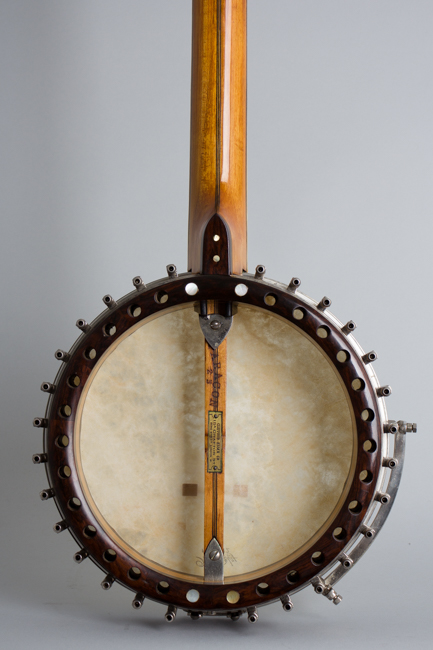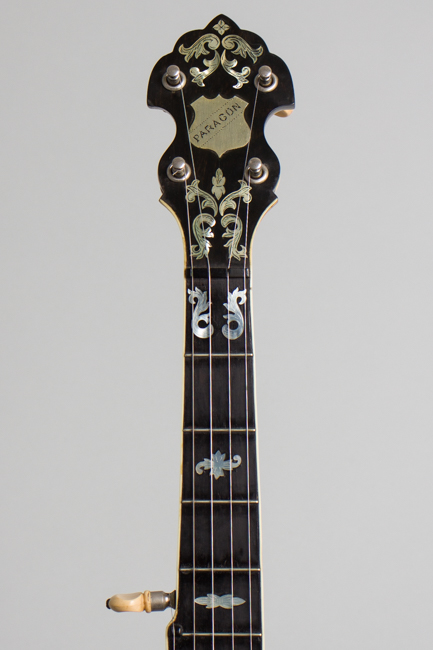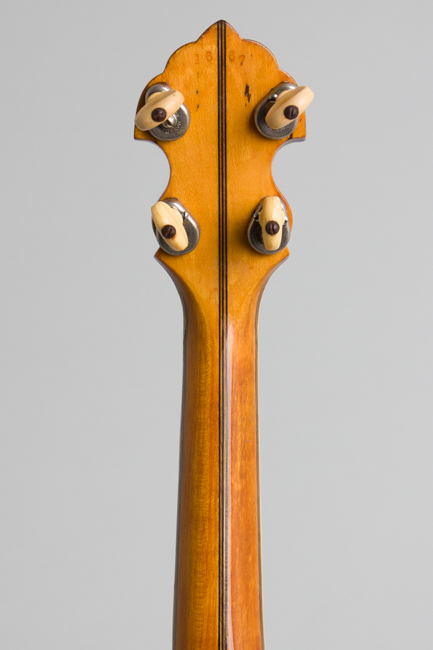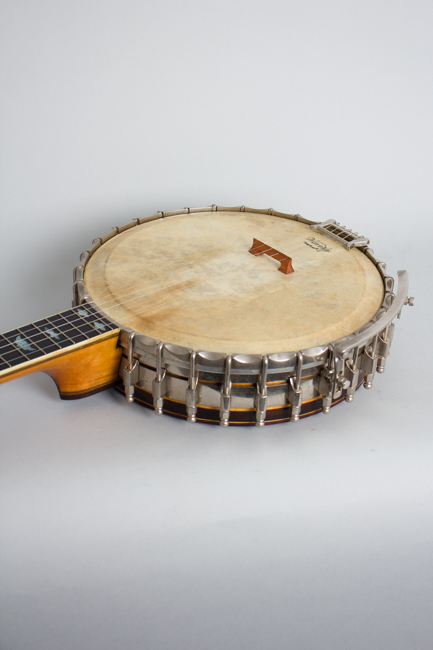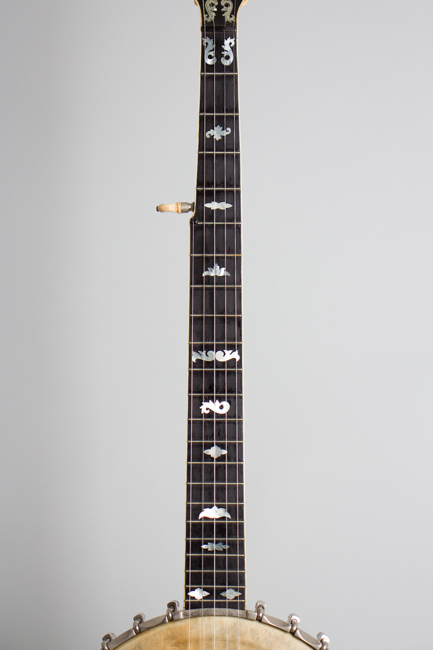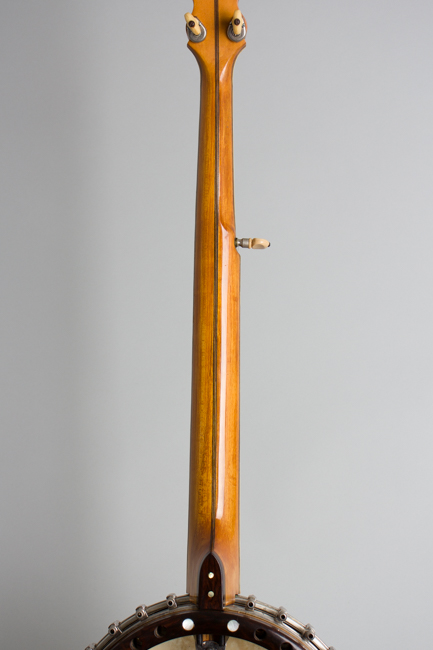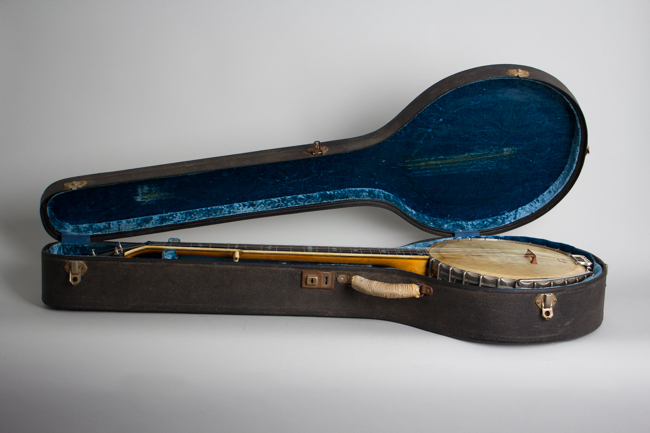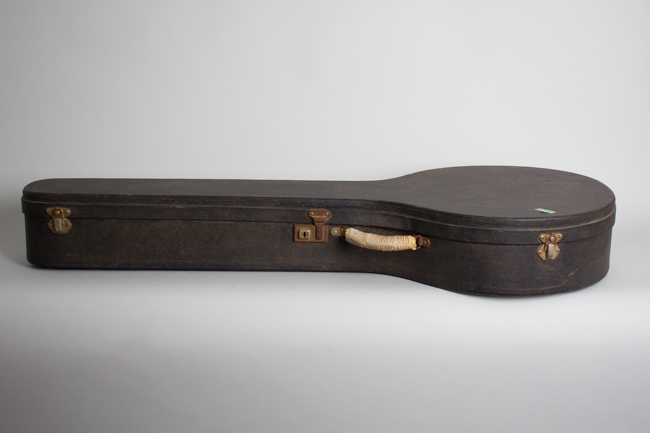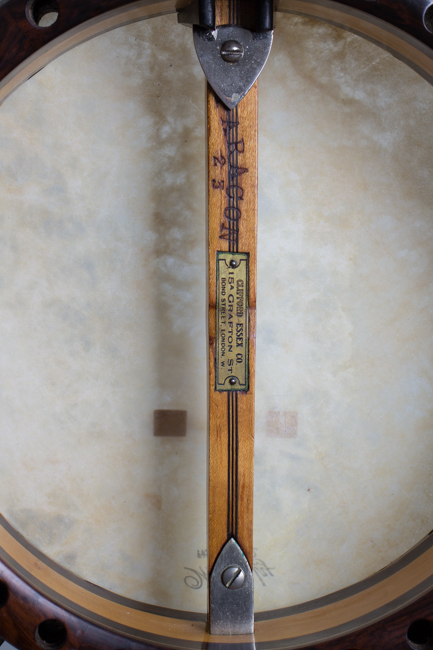Clifford Essex Paragon 5 String Banjo (1924)
This item has been sold.
Item # 10481
Prices subject to change without notice.
Clifford Essex Paragon Model 5 String Banjo (1924), made in London, England, serial # 23, natural finish, laminated maple, ebony and rosewood rim, laminated maple neck with ebony fingerboard, black hard shell case.
This banjo is not quite 100 years old, a very early example of what was at that time the best (and certainly most modern) banjo yet built in England. Some would say these early Clifford Essex Paragon banjos remain as fine as any ever made in the UK; they are particularly prized by Irish-style musicians. As a result Paragons may be the only vintage banjos where a five-string like this is not valued highly over the tenor version!
This is a fully "American styled" instrument, quite different from the daintier Zither Banjos Essex was known for then still popular in the British Isles. This is a large, heavy and imposing banjo, very well built and designed to challenge the quality and sound of the American-made Vega and Paramount banjos that were the world standard. The name "Paragon" may have been cheekily selected to suggest the Paramount, but the design is far from a mere copy of US originals.
In 1924 the name Clifford Essex was already a venerable brand in England. He was originally a notable banjo player and teacher who entered the business of selling instruments in 1883. Early banjos were produced by various factories, originally branded Essex & Cammeyer reflecting a partnership with that noted American player/designer. By 1900 that was dissolved and Clifford Essex logo instruments were mostly being made in house.
The Paragon brand was introduced in June 1924, launched with some fanfare via advertisements in the Clifford Essex-published magazine BMG. The earliest Serial numbers ranged from 1 up to around 300; this one has #23 stamped on the dowel under the arched Paragon logo and bears the maker's inlaid address plate "Clifford Essex and Co. 15A Grafton Street London W". The heavy rosewood capped maple rim has holes drilled top to bottom, topped with a large hollow sheathed arch-top tone ring with holes facing inward. The shoes are mounted on a bracket band ala Vega's design, but more massive. The heavy hoop is fluted around the top edge, a distinctive Paragon touch. All the hardware is unique and of British origin except for US-made Waverly "spike" tuners, one of the earliest geared pegs available. There is a very small 4-digit number stamped on the back of the headstock; the significance of this is obscure as Paragon serial number is always on the dowel.
The 26 1/2' scale five string neck is made of multi-laminate maple and ebony, with fairly chunky profile and a bound ebony fingerboard. This and the ebony headstock facing are finely inlaid with engraved pearl. This banjo has fairly massive hardware and construction all around but at 8 1/4 Lbs. is not overly heavy, thanks to those rim chambers. Originally this banjo had a resonator, that is long gone but the mounting bracket is still in the case. It appears to have been played many decades in openback 5-string configuration. As such it is quite loud but with a mellower tone than might be expected and a nice old-timey ring. This banjo cost 25 guineas new, quite a bit at the time and almost 100 years on represents a real bargain in a high quality vintage 5-string.
Overall length is 36 1/4 in. (92.1 cm.), 11 3/16 in. (28.4 cm.) diameter head, and 3 in. (7.6 cm.) in depth, measured at side of rim. Scale length is 26 1/2 in. (673 mm.). Width of nut is 1 1/4 in. (32 mm.).
This is a generally well preserved banjo, especially for nearly a century on the planet and having traveled far from its London origins. The neck and rim were overfinished long ago with a hand-rubbed clear coat, something old "banjo guys' used to love to do. It is not overly thick but somewhat scrubby looking in spots. The dowel retains the original thin varnish finish. There has been some general wear since but overall this is pretty clean banjo for 98 years on. The plating on the hardware shows only light clouding and minimal corrosion; it does not appear to have ever been re-plated.
Everything on the instrument appears original except the head (a Waverly Fiberskyn) and probably the bridge. The unique tailpiece and Paramount style armrest are still intact. The frets appear original and show very little wear. As noted an originally fitted resonator has likely been missing for many decades; the mounting hardware for attaching it to the dowel is still in the case. This is a fine playing, high quality instrument, very handsome to look at and a lovely and unique banjo to play. These are very rare here in the US having never been imported to these shores and this is the first Paragon we have ever offered. It lives in a later (1960-70s0 HSC and we swear seems to twang with an English accent!
Overall Excellent Condition.
This banjo is not quite 100 years old, a very early example of what was at that time the best (and certainly most modern) banjo yet built in England. Some would say these early Clifford Essex Paragon banjos remain as fine as any ever made in the UK; they are particularly prized by Irish-style musicians. As a result Paragons may be the only vintage banjos where a five-string like this is not valued highly over the tenor version!
This is a fully "American styled" instrument, quite different from the daintier Zither Banjos Essex was known for then still popular in the British Isles. This is a large, heavy and imposing banjo, very well built and designed to challenge the quality and sound of the American-made Vega and Paramount banjos that were the world standard. The name "Paragon" may have been cheekily selected to suggest the Paramount, but the design is far from a mere copy of US originals.
In 1924 the name Clifford Essex was already a venerable brand in England. He was originally a notable banjo player and teacher who entered the business of selling instruments in 1883. Early banjos were produced by various factories, originally branded Essex & Cammeyer reflecting a partnership with that noted American player/designer. By 1900 that was dissolved and Clifford Essex logo instruments were mostly being made in house.
The Paragon brand was introduced in June 1924, launched with some fanfare via advertisements in the Clifford Essex-published magazine BMG. The earliest Serial numbers ranged from 1 up to around 300; this one has #23 stamped on the dowel under the arched Paragon logo and bears the maker's inlaid address plate "Clifford Essex and Co. 15A Grafton Street London W". The heavy rosewood capped maple rim has holes drilled top to bottom, topped with a large hollow sheathed arch-top tone ring with holes facing inward. The shoes are mounted on a bracket band ala Vega's design, but more massive. The heavy hoop is fluted around the top edge, a distinctive Paragon touch. All the hardware is unique and of British origin except for US-made Waverly "spike" tuners, one of the earliest geared pegs available. There is a very small 4-digit number stamped on the back of the headstock; the significance of this is obscure as Paragon serial number is always on the dowel.
The 26 1/2' scale five string neck is made of multi-laminate maple and ebony, with fairly chunky profile and a bound ebony fingerboard. This and the ebony headstock facing are finely inlaid with engraved pearl. This banjo has fairly massive hardware and construction all around but at 8 1/4 Lbs. is not overly heavy, thanks to those rim chambers. Originally this banjo had a resonator, that is long gone but the mounting bracket is still in the case. It appears to have been played many decades in openback 5-string configuration. As such it is quite loud but with a mellower tone than might be expected and a nice old-timey ring. This banjo cost 25 guineas new, quite a bit at the time and almost 100 years on represents a real bargain in a high quality vintage 5-string.
Overall length is 36 1/4 in. (92.1 cm.), 11 3/16 in. (28.4 cm.) diameter head, and 3 in. (7.6 cm.) in depth, measured at side of rim. Scale length is 26 1/2 in. (673 mm.). Width of nut is 1 1/4 in. (32 mm.).
This is a generally well preserved banjo, especially for nearly a century on the planet and having traveled far from its London origins. The neck and rim were overfinished long ago with a hand-rubbed clear coat, something old "banjo guys' used to love to do. It is not overly thick but somewhat scrubby looking in spots. The dowel retains the original thin varnish finish. There has been some general wear since but overall this is pretty clean banjo for 98 years on. The plating on the hardware shows only light clouding and minimal corrosion; it does not appear to have ever been re-plated.
Everything on the instrument appears original except the head (a Waverly Fiberskyn) and probably the bridge. The unique tailpiece and Paramount style armrest are still intact. The frets appear original and show very little wear. As noted an originally fitted resonator has likely been missing for many decades; the mounting hardware for attaching it to the dowel is still in the case. This is a fine playing, high quality instrument, very handsome to look at and a lovely and unique banjo to play. These are very rare here in the US having never been imported to these shores and this is the first Paragon we have ever offered. It lives in a later (1960-70s0 HSC and we swear seems to twang with an English accent!
Overall Excellent Condition.
